
| Running,jumping,burrowing or even tree-climbing, frogs can be found in almost any Australian landscape - desert claypans, freezing mountains and inner-city suburbs.This stunning selection from more than 220 named Australian species includes common frogs and others so rare you should contact wildlife authorities if you find one. |
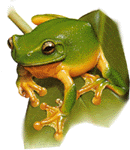 |
 Dainty green tree frog
Dainty green tree frogSize:To 45mm Where:In streamside vegetation and dense plantation crops. Renowned for travelling south with farm produce - particularly bananas - this frog is difficult to detect in a mass of fruit or foliage because to minimise water loss it seals itself to a leaf with secretions.In some southern cities animal welfare groups have developed schemes to return these hitchhikers to their home range. |
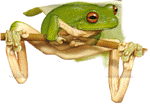 |
 Red-eyed tree frog
Red-eyed tree frogSize:Males to 62mm, females to 68mm Where:In forest pools and streams after spring and summer rains. This much-photographed frog lives in the rainforest canopy,coming down to breed after rain.It has been known to launch itself from a high branch after insects and land safely many metres below.Extensive webbing on its feet and its adoption of a gliderlike posture in midair suggest the species may be developing the ability to control such descents. |
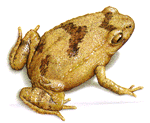 |
 Pouched frog
Pouched frogSize:To 28mm Where:High in rainforested areas, in moist leaf litter and beneath rocks and logs. When the pouched frog's eggs hatch beneath leaf litter, the blind, white tadpoles wriggle up the waiting male's back and into slit pockets in his flanks. There they metamorphose, protected from predators and fast-flowing stream currents, emerging as tiny froglets after about 70 days. |
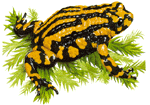 |
 Pouched frog
Pouched frogSize:Males to 28mm, females to 30mm Where:Above the tree line in sphagnum bogs, below the tree line under logs and debris. Instantly recognisable, this vivid ant- and mite-eating frog is usually depicted as having broad yellow and black stripes, but these markings are found only on those living near Mt.Kosciuszko.The northern form, which lives in high country extending into the ACT,has narrower stripes ranging from yellow to lime-green. |
 |
 Blue Mountains tree frog
Blue Mountains tree frogSize:To 60mm Where:By streams in thick forest. Although one of Australia's most beautiful frogs, this shy river-dweller is rarely seen.It shelters under rocks and is agile in and out of the water.The dark-brown tadpoles have transparent fins flecked with metallic gold spots. |
 |
 Sunset frog
Sunset frogSize:To 35mm Where:Thought to live in just five small peat swamps near Walpole, south-west WA. Molecular studies suggest the gorgeously coloured sunset frog has a lineage extending back more than 30 million years, yet science only became aware of its existence in 1994. It has one of the most restricted ranges of any Australian vertebrate, with a known range of just 50-70 ha. |
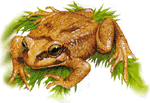 |
 Moss froglet
Moss frogletSize:To 30mm Where:Above the tree line in mountainside moss beds and down to an altitude of about 900 m. Its scientific name, which can be translated in part as "of the clouds", indicates why this little animal was only chanced upon in 1994.Dwelling in mountainside moss beds in Tasmania's south-west, it stays dormant during autumn and winter.The tadpoles develop and metamorphose inside their eggs rather than in freezing mountain tarns. |
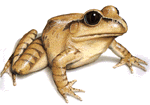 |
 Great barred frog
Great barred frogSize:Males to 65mm, females to 101mm Where:Near rainforest streams and farm dams at night. A large, handsome frog, the great barred frog's dark eyes distinguish it from other Mixophyes that share its range. Similar-looking frogs with golden eyes, or blue or silver upper eyes are endangered members of the genus.The great barred frog's readiness to breed in dams and other enclosed waterways has helped it weather impacts affecting its stream-dwelling relatives. |
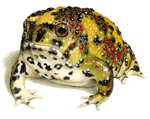 |
 Crucifix toad
Crucifix toadSize:Males to 63mm, females to 68mm Where:Across its range after heavy rain. When this distinctive frog emerges from long periods underground to breed after flooding rains, it often waddles to the nearest ant nest and eats as many of the inhabitants as it can manage, seemingly impervious to their stings. In NSW it is commonly seen at Easter after rain, resembling a bright hot cross bun. |
 |
 Rockhole frog
Rockhole frogSize:to 21mm Where:Around rockholes by day and night. This creature's ability to jump across the water's surface gave rise to its unofficial name, the Jesus Christ frog. Unlike most other frogs it's active during the day. |
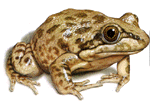 |
 Spotted grass frog
Spotted grass frogSize:Males to 42mm, females to 47mm Where:Under debris near water, particularly in marshland. A rapid coloniser of backyard ponds and ditches, the spotted grass frog is tough and versatile.Its call has three regional dialects - each a series of clicks at a varying rate. Like other Limnodynastes, it floats its eggs in warm surface water on a foam raft formed by the female's padding action during mating. |
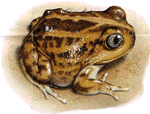 |
 Goldfields bull frog
Goldfields bull frogSize:Males to 61mm, females to 63mm Where:Claypans after heavy summer rain. For one or two nights after heavy rain, this species will suddenly appear in abundance, the males calling, brawling and mating with almost anything the right size and shape. Then, as rapidly as they appeared, the frogs vanish back into the earth, to wait months or years for the next breeding oppotunity. |
 |
 Red-crowned toadlet
Red-crowned toadletSize:To 30mm Where:Around moist seepages or crevices in Sydney sandstone. Vivid colouring warns potential predators that this frog produces deadly toxins - as potent as those of South America's infamous poison arrow frogs. If you handle the toadlets your hands should be washed immediately afterwards - a precaution that should be taken with all frogs. |
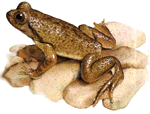 |
 Southern gastric brooding frog
Southern gastric brooding frogSize:Males to 41mm, females to 54mm Where:Under boulders along fast-flowing stony creeks and in pools in Queensland's Conondale and Blackall ranges. This extraordinary amphibian is now feared extinct.It is believed that after mating the female swallows the fertilised eggs, stops eating and her stomack ceases digestive contractions and gastric-acid production. The eggs hatch into tadpoles and metamorphose in her stomack, emerging from her mouth after about six weeks as fully developed froglets. |
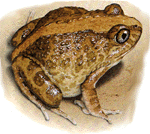 |
 Ornate burrowing frog
Ornate burrowing frogSize:Males to 37mm, females to 42mm Where:Almost anywhere in its range after heavy rain. Although often encountered, this frog is not always instantly identifiable because of the extreme variability of the species' markings.After waiting out dry periods in sandy soil, the males float spread-eagled in rainwater puddles and call for mates.In warm northern waters the frog's foam nests often collapse so the eggs appear to be floating in a film. |
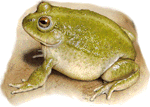 |
 Water-holding frog
Water-holding frogSize:Males to 64mm, females to 72mm Where:In ephemeral billabongs and gilgais (cracked clayey depressions). One of only four aquatic frogs (those able to feed underwater) known to live in Australia, this frog inhabits the continent's driest areas, hunting in gilgais after rain for insects, shrimps and tadpoles. It waits out dry times beneath the ground, living for up to seven years on its own fat and water trapped in its tissues and under its skin. |
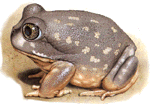 |
 Western spotted frog
Western spotted frogSize:Males to 77mm, females to 85mm Where:Burrows under rocks and in the banks of watercourses and claypans. The males of this stout, distinctive frog species call from the mouths of their burrows when winter rains begin falling in April or May.Eggs are laid within the burrow in a foam nest.As the rains continue, water rises through the burrow, carrying the hatched tadpoles into nearby waterways. |
 |
 Turtle frog
Turtle frogSize:Males to 42mm, females to 50mm Where:On sandy soil after rain or beneath logs away from water. This distinctive-looking creature, sometimes mistaken for a young turtle, feasts on termites and spends summers in sand up to 1.5m underground. Using its stubby, powerful forelimbs, the turtle frog burrows headfirst, like only one other Australian frog - the sandhill frog, which lives on the coastal plain north of the turtle frog's range. |
 |
 Green-thighed frog
Green-thighed frogSize:Males to 43mm, females to 47mm Where:In flooded paddocks, woodland or rainforest after very heavy rain, or in forest leaf litter. Despite the striking colour of this frog's belly, thighs and sides, from above it blends so well with leaf litter that it wasn't described until 1972. Little is known about its habits.During a wet phase it will briefly appear in large numbers, then seem to vanish for several years. |
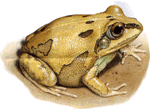 |
 Daly Waters frog
Daly Waters frogSize:To 55mm Where:Near grassland claypans after heavy rain. The wide mouth of this striking frog enables it to gorge on insects and other frogs for brief periods after rain, when the claypans in its arid habitat hold water.As the claypans dry out, the frog imprisons itself in an underground chamber coated with its own slime, until the next heavy rains release it. |
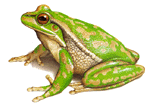 |
 Green and golden bell frog
Green and golden bell frogSize:Males to 69mm, females to 108mm Where:In disused excavations or among rushes in permanent ponds. Once common, this frog is now endangered in NSW, partly because of predation of its tadpoles by an introduced fish, the eastern gambusia, and habitat destruction.Fortunately it's capable of living in old industrial sites, quarries and home gardens. |
ページトップ↑